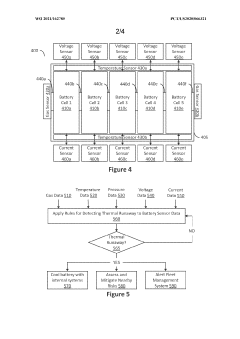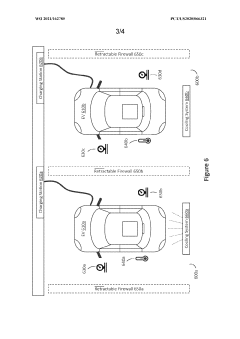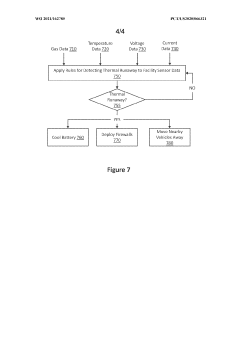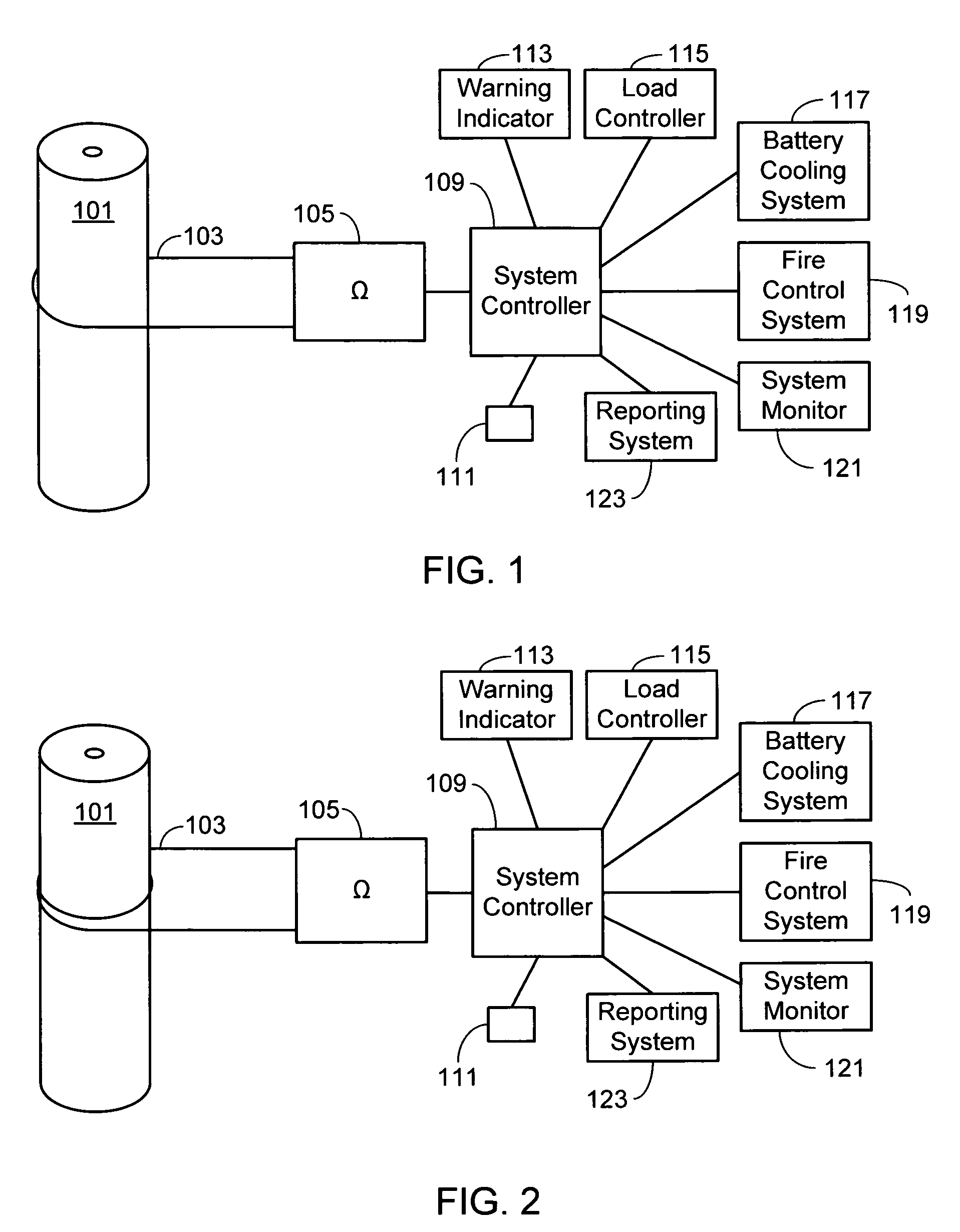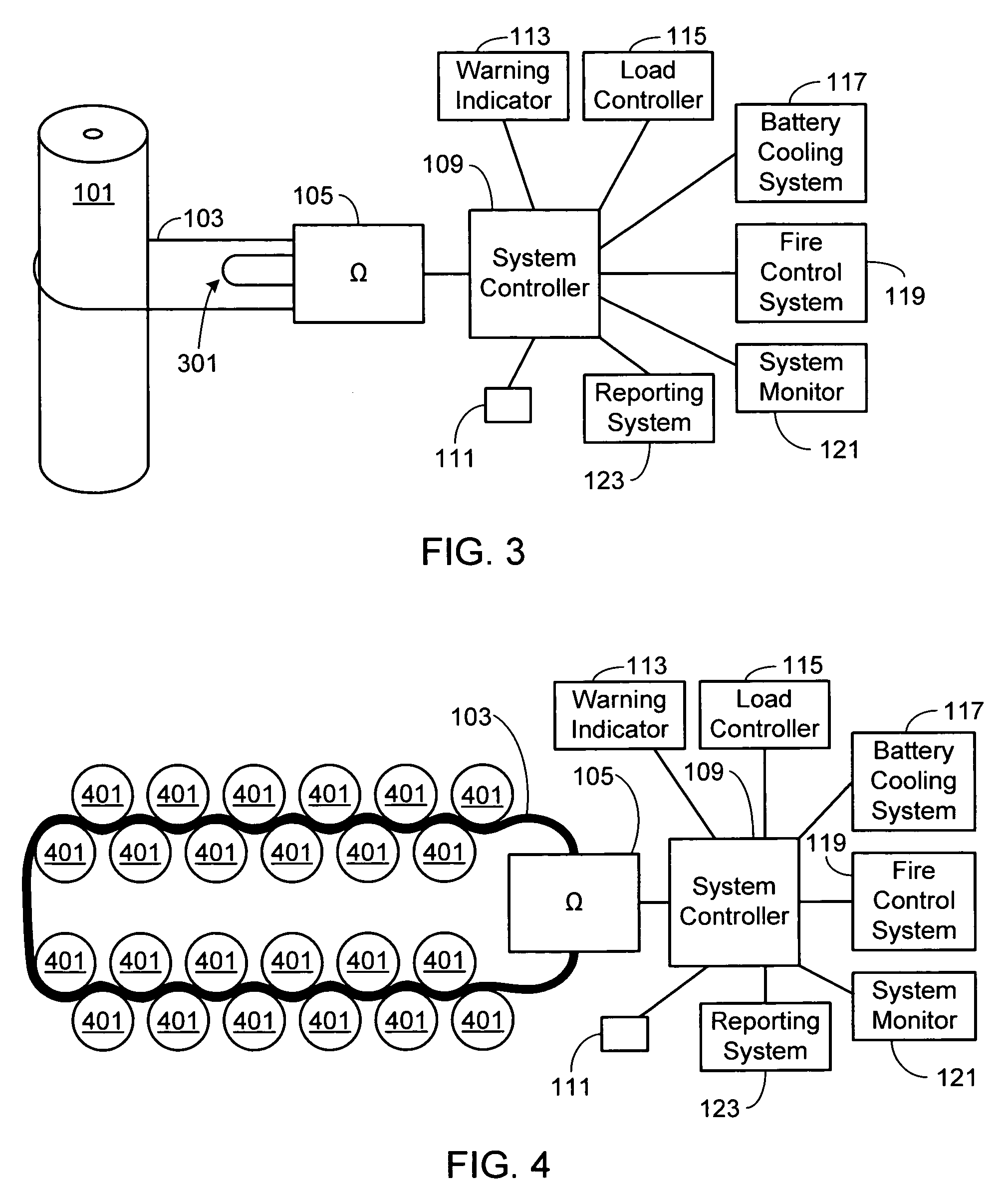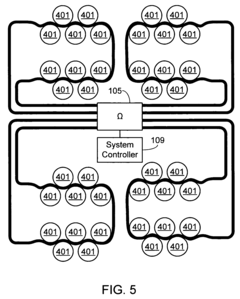Patent analysis of thermal runaway sensors for aerospace battery safety
OCT 9, 20259 MIN READ
Generate Your Research Report Instantly with AI Agent
Patsnap Eureka helps you evaluate technical feasibility & market potential.
Aerospace Battery Thermal Runaway Sensing: Background and Objectives
Lithium-ion batteries have become the predominant energy storage solution for aerospace applications due to their high energy density, long cycle life, and relatively low maintenance requirements. However, these advantages come with inherent safety risks, particularly the phenomenon known as thermal runaway. This catastrophic failure mode occurs when a battery cell enters an uncontrollable, self-heating state that can lead to fire, explosion, and the release of toxic gases. In the confined environment of aircraft or spacecraft, such failures pose extreme dangers to personnel, equipment, and mission success.
The evolution of aerospace battery technology has seen significant advancements in energy density and performance over the past two decades, with lithium-ion chemistries replacing nickel-cadmium and nickel-metal hydride systems. This transition has enabled longer mission durations and reduced weight penalties but has simultaneously increased safety concerns. The Boeing 787 Dreamliner battery incidents of 2013 served as a watershed moment for the aerospace industry, highlighting the critical need for advanced thermal runaway detection and prevention systems.
Current aerospace safety standards, including DO-311A and NASA-specific requirements, mandate robust battery management systems with multiple layers of protection. Early detection of thermal runaway precursors has emerged as a critical research focus, as conventional protection mechanisms often activate too late in the failure cascade to prevent catastrophic outcomes. The technical objective in this field is to develop sensing technologies capable of detecting thermal runaway conditions at their earliest stages, providing sufficient time for intervention before the process becomes irreversible.
Patent activity in aerospace battery thermal runaway sensing has accelerated dramatically since 2015, with particular emphasis on multi-modal sensing approaches that combine temperature, gas, pressure, and electrochemical measurements. These developments aim to achieve detection reliability exceeding 99.999% while maintaining extremely low false-positive rates—a challenging balance in the aerospace context where both missed detections and unnecessary emergency procedures carry severe consequences.
The technical goals for next-generation thermal runaway sensors include miniaturization to accommodate space constraints, radiation hardening for space applications, integration with existing battery management systems, and the capability to function reliably across extreme temperature ranges (-40°C to +85°C). Additionally, there is growing interest in predictive capabilities that leverage machine learning algorithms to identify subtle precursor patterns hours or even days before a thermal event might occur.
Research efforts are increasingly focused on non-invasive sensing methodologies that can be retrofitted to existing battery systems without compromising their performance or adding significant weight—a crucial consideration for aerospace applications where every gram impacts fuel efficiency and payload capacity.
The evolution of aerospace battery technology has seen significant advancements in energy density and performance over the past two decades, with lithium-ion chemistries replacing nickel-cadmium and nickel-metal hydride systems. This transition has enabled longer mission durations and reduced weight penalties but has simultaneously increased safety concerns. The Boeing 787 Dreamliner battery incidents of 2013 served as a watershed moment for the aerospace industry, highlighting the critical need for advanced thermal runaway detection and prevention systems.
Current aerospace safety standards, including DO-311A and NASA-specific requirements, mandate robust battery management systems with multiple layers of protection. Early detection of thermal runaway precursors has emerged as a critical research focus, as conventional protection mechanisms often activate too late in the failure cascade to prevent catastrophic outcomes. The technical objective in this field is to develop sensing technologies capable of detecting thermal runaway conditions at their earliest stages, providing sufficient time for intervention before the process becomes irreversible.
Patent activity in aerospace battery thermal runaway sensing has accelerated dramatically since 2015, with particular emphasis on multi-modal sensing approaches that combine temperature, gas, pressure, and electrochemical measurements. These developments aim to achieve detection reliability exceeding 99.999% while maintaining extremely low false-positive rates—a challenging balance in the aerospace context where both missed detections and unnecessary emergency procedures carry severe consequences.
The technical goals for next-generation thermal runaway sensors include miniaturization to accommodate space constraints, radiation hardening for space applications, integration with existing battery management systems, and the capability to function reliably across extreme temperature ranges (-40°C to +85°C). Additionally, there is growing interest in predictive capabilities that leverage machine learning algorithms to identify subtle precursor patterns hours or even days before a thermal event might occur.
Research efforts are increasingly focused on non-invasive sensing methodologies that can be retrofitted to existing battery systems without compromising their performance or adding significant weight—a crucial consideration for aerospace applications where every gram impacts fuel efficiency and payload capacity.
Market Demand Analysis for Aerospace Battery Safety Systems
The aerospace battery market is experiencing significant growth, driven by the increasing adoption of electric propulsion systems and the rising demand for more electric aircraft (MEA). According to market research, the global aerospace battery market is projected to reach $7.8 billion by 2030, growing at a CAGR of 8.5% from 2023. Within this expanding market, battery safety systems, particularly thermal runaway detection technologies, represent a critical segment with accelerating demand.
The need for advanced thermal runaway sensors in aerospace applications stems from several converging factors. First, the aviation industry's shift toward higher energy density batteries to support electrification initiatives has inherently increased safety risks. Lithium-ion batteries, while offering superior performance characteristics, present significant thermal runaway hazards that can lead to catastrophic failures in aerospace environments.
Regulatory bodies including the FAA, EASA, and CAAC have responded by implementing increasingly stringent safety requirements for aerospace battery systems. The FAA's 2018 mandate requiring smoke detection systems capable of identifying battery thermal events has been a key market driver, compelling aircraft manufacturers and operators to invest in advanced detection technologies.
Commercial aviation represents the largest market segment for these safety systems, with business jets and military aircraft following closely behind. The urban air mobility (UAM) sector, though nascent, is expected to become a significant market for battery safety systems as electric vertical takeoff and landing (eVTOL) vehicles move toward commercialization in the 2025-2030 timeframe.
Market analysis reveals a strong correlation between battery capacity increases and safety system investments. For every 10% increase in battery energy density, safety system expenditures typically rise by 15-20%, highlighting the industry's recognition of elevated risks associated with higher-performance batteries.
Customer requirements in this space emphasize early detection capabilities, with aerospace OEMs seeking systems that can identify thermal runaway precursors at least 5-10 minutes before catastrophic failure. Additional market demands include minimal false alarm rates, lightweight designs (under 2% of total battery system weight), and integration capabilities with existing aircraft management systems.
The aftermarket segment for retrofitting existing aircraft with improved battery safety systems is growing at 12% annually, outpacing the overall market. This trend reflects operators' increasing awareness of battery safety risks and willingness to invest in protective technologies even for legacy aircraft.
Geographic analysis shows North America leading the market with approximately 40% share, followed by Europe (30%) and Asia-Pacific (25%), with the latter showing the fastest growth rate due to expanding aerospace manufacturing capabilities in China and Japan.
The need for advanced thermal runaway sensors in aerospace applications stems from several converging factors. First, the aviation industry's shift toward higher energy density batteries to support electrification initiatives has inherently increased safety risks. Lithium-ion batteries, while offering superior performance characteristics, present significant thermal runaway hazards that can lead to catastrophic failures in aerospace environments.
Regulatory bodies including the FAA, EASA, and CAAC have responded by implementing increasingly stringent safety requirements for aerospace battery systems. The FAA's 2018 mandate requiring smoke detection systems capable of identifying battery thermal events has been a key market driver, compelling aircraft manufacturers and operators to invest in advanced detection technologies.
Commercial aviation represents the largest market segment for these safety systems, with business jets and military aircraft following closely behind. The urban air mobility (UAM) sector, though nascent, is expected to become a significant market for battery safety systems as electric vertical takeoff and landing (eVTOL) vehicles move toward commercialization in the 2025-2030 timeframe.
Market analysis reveals a strong correlation between battery capacity increases and safety system investments. For every 10% increase in battery energy density, safety system expenditures typically rise by 15-20%, highlighting the industry's recognition of elevated risks associated with higher-performance batteries.
Customer requirements in this space emphasize early detection capabilities, with aerospace OEMs seeking systems that can identify thermal runaway precursors at least 5-10 minutes before catastrophic failure. Additional market demands include minimal false alarm rates, lightweight designs (under 2% of total battery system weight), and integration capabilities with existing aircraft management systems.
The aftermarket segment for retrofitting existing aircraft with improved battery safety systems is growing at 12% annually, outpacing the overall market. This trend reflects operators' increasing awareness of battery safety risks and willingness to invest in protective technologies even for legacy aircraft.
Geographic analysis shows North America leading the market with approximately 40% share, followed by Europe (30%) and Asia-Pacific (25%), with the latter showing the fastest growth rate due to expanding aerospace manufacturing capabilities in China and Japan.
Current State and Challenges in Thermal Runaway Detection
The current landscape of thermal runaway detection in aerospace battery systems reveals a complex interplay of technological advancements and persistent challenges. Globally, research institutions and aerospace companies have made significant strides in developing sensors capable of early detection, yet implementation barriers remain substantial. The primary detection methodologies currently employed include temperature monitoring systems, voltage fluctuation analysis, gas sensors, and impedance-based detection mechanisms, each with varying degrees of effectiveness and reliability.
Temperature monitoring represents the most widely adopted approach, with patents showing sophisticated multi-point sensing arrays that can identify thermal gradients across battery packs. However, these systems often suffer from delayed response times, as external temperature changes may only become detectable after thermal runaway has initiated internally. This critical time lag presents a major challenge for aerospace applications where rapid response is essential.
Voltage monitoring technologies have evolved to detect subtle fluctuations that precede thermal events, with recent patents demonstrating algorithms capable of distinguishing between normal operational variations and precursors to thermal runaway. Despite these advances, false positives remain problematic, particularly in the variable environmental conditions experienced during flight operations.
Gas detection systems represent a promising frontier, with sensors designed to identify the specific gaseous emissions that occur in early-stage battery degradation. Patents in this area show increasing sensitivity and selectivity, though miniaturization for aerospace integration remains challenging. Additionally, these systems must contend with the confined spaces of aircraft battery compartments, where gas dispersion patterns can be unpredictable.
Impedance-based detection has gained traction in recent years, with patents revealing sophisticated spectroscopic techniques that can identify internal resistance changes indicative of impending failure. However, these systems typically require complex signal processing and are susceptible to electromagnetic interference common in aerospace environments.
A significant technical hurdle across all methodologies is the integration of these sensing technologies with aircraft systems without adding prohibitive weight or power requirements. Patents reveal ongoing efforts to develop lightweight, low-power consumption sensors, but the aerospace industry's stringent certification requirements often slow implementation of novel technologies.
Geographically, thermal runaway detection technology development shows concentration in North America, East Asia, and Europe, with particular innovation clusters around major aerospace manufacturing centers. Chinese patents have shown remarkable growth in this field over the past five years, particularly in the area of multi-modal sensing approaches that combine different detection methodologies.
Temperature monitoring represents the most widely adopted approach, with patents showing sophisticated multi-point sensing arrays that can identify thermal gradients across battery packs. However, these systems often suffer from delayed response times, as external temperature changes may only become detectable after thermal runaway has initiated internally. This critical time lag presents a major challenge for aerospace applications where rapid response is essential.
Voltage monitoring technologies have evolved to detect subtle fluctuations that precede thermal events, with recent patents demonstrating algorithms capable of distinguishing between normal operational variations and precursors to thermal runaway. Despite these advances, false positives remain problematic, particularly in the variable environmental conditions experienced during flight operations.
Gas detection systems represent a promising frontier, with sensors designed to identify the specific gaseous emissions that occur in early-stage battery degradation. Patents in this area show increasing sensitivity and selectivity, though miniaturization for aerospace integration remains challenging. Additionally, these systems must contend with the confined spaces of aircraft battery compartments, where gas dispersion patterns can be unpredictable.
Impedance-based detection has gained traction in recent years, with patents revealing sophisticated spectroscopic techniques that can identify internal resistance changes indicative of impending failure. However, these systems typically require complex signal processing and are susceptible to electromagnetic interference common in aerospace environments.
A significant technical hurdle across all methodologies is the integration of these sensing technologies with aircraft systems without adding prohibitive weight or power requirements. Patents reveal ongoing efforts to develop lightweight, low-power consumption sensors, but the aerospace industry's stringent certification requirements often slow implementation of novel technologies.
Geographically, thermal runaway detection technology development shows concentration in North America, East Asia, and Europe, with particular innovation clusters around major aerospace manufacturing centers. Chinese patents have shown remarkable growth in this field over the past five years, particularly in the area of multi-modal sensing approaches that combine different detection methodologies.
Current Patent Landscape for Thermal Runaway Detection
01 Temperature monitoring systems for battery safety
Advanced temperature monitoring systems are essential for detecting early signs of thermal runaway in batteries. These systems utilize various temperature sensors strategically placed within battery packs to continuously monitor thermal conditions. When abnormal temperature rises are detected, the systems can trigger safety protocols such as power reduction, cooling activation, or complete shutdown to prevent thermal runaway progression. These monitoring systems often incorporate predictive algorithms to anticipate potential thermal events before they reach critical stages.- Temperature monitoring systems for battery safety: Advanced temperature monitoring systems are crucial for detecting early signs of thermal runaway in batteries. These systems utilize various sensors to continuously monitor temperature changes and fluctuations within battery cells or packs. When abnormal temperature patterns are detected, the system can trigger alerts or activate safety mechanisms to prevent thermal runaway progression. These monitoring systems often incorporate multiple temperature sensors strategically placed throughout the battery system for comprehensive coverage and early detection capabilities.
- Gas detection sensors for thermal runaway prevention: Gas detection sensors play a vital role in thermal runaway safety by identifying the release of gases that precede or accompany thermal events. These sensors can detect specific gases like hydrogen, carbon monoxide, or volatile organic compounds that are emitted during the early stages of battery degradation or thermal runaway. By detecting these gas emissions before significant temperature increases occur, safety systems can implement preventive measures earlier. These sensors are often integrated with other monitoring systems to provide multi-parameter detection for enhanced safety.
- Integrated safety systems with multiple sensor types: Comprehensive thermal runaway protection often involves integrated safety systems that combine multiple sensor types working in concert. These systems may incorporate temperature sensors, gas detectors, voltage monitors, and current sensors to provide redundant safety monitoring. The integration of diverse sensor data allows for more accurate detection of potential thermal events through correlation of multiple parameters. These systems typically include sophisticated algorithms that can distinguish between normal operational variations and genuine safety concerns, reducing false alarms while maintaining high safety standards.
- Early warning systems and predictive analytics: Advanced thermal runaway safety solutions utilize early warning systems enhanced by predictive analytics and machine learning algorithms. These systems analyze sensor data patterns to predict potential thermal events before they occur. By monitoring subtle changes in battery parameters over time, these systems can identify degradation patterns that may lead to thermal runaway. The predictive capabilities allow for preventive maintenance or safety interventions before critical thresholds are reached, significantly improving overall battery safety management and extending the safe operational life of battery systems.
- Physical isolation and containment technologies: Physical isolation and containment technologies represent a critical aspect of thermal runaway safety. These include specially designed materials and structures that can physically contain thermal events and prevent propagation between cells or modules. Sensors within these systems monitor the effectiveness of the containment and can trigger additional safety responses when needed. These technologies often incorporate heat-resistant barriers, phase-change materials for heat absorption, and pressure relief mechanisms that work together with sensor systems to minimize damage and prevent cascading failures in battery systems during thermal events.
02 Gas detection sensors for early thermal runaway warning
Gas detection sensors provide early warning of thermal runaway by identifying specific gases released during the initial decomposition stages of battery materials. These sensors can detect volatile organic compounds, hydrogen, carbon monoxide, and other gases that precede visible thermal events. By monitoring gas emissions, safety systems can respond to potential thermal runaway conditions before significant temperature increases occur, allowing for preventative measures to be implemented. These sensors are often integrated with battery management systems to provide comprehensive safety monitoring.Expand Specific Solutions03 Integrated multi-parameter sensing systems
Multi-parameter sensing systems combine different sensor types to provide comprehensive thermal runaway detection. These systems integrate temperature, voltage, current, pressure, and gas sensors to monitor multiple indicators simultaneously. By analyzing the correlation between different parameters, these systems can distinguish between normal operational fluctuations and actual thermal runaway precursors, reducing false alarms while improving detection reliability. Advanced systems may incorporate machine learning algorithms to continuously improve detection accuracy based on operational data.Expand Specific Solutions04 Mechanical safety features and pressure sensors
Mechanical safety features work alongside electronic sensors to prevent and mitigate thermal runaway events. These include pressure sensors that detect internal pressure buildup within cells, pressure relief mechanisms that safely vent gases, and physical barriers that prevent thermal propagation between cells. Some designs incorporate deformable components that respond to pressure or temperature changes by breaking electrical connections or triggering cooling systems. These mechanical features provide redundant safety measures that function even if electronic monitoring systems fail.Expand Specific Solutions05 Battery management systems with thermal runaway prevention
Advanced battery management systems integrate sensor data with control algorithms to actively prevent thermal runaway conditions. These systems continuously analyze battery parameters to identify potential safety risks and implement preventive measures such as load balancing, charge limiting, or selective cell isolation. When abnormal conditions are detected, the management system can implement graduated response protocols based on the severity of the detected anomaly. Some systems incorporate remote monitoring capabilities that allow for expert intervention or data analysis to improve safety protocols over time.Expand Specific Solutions
Key Players in Aerospace Battery Safety Sensor Industry
The aerospace battery safety market for thermal runaway sensors is in an early growth phase, characterized by increasing adoption as battery technologies proliferate in aviation applications. The market is expanding rapidly, driven by stringent safety regulations and growing electrification trends in aerospace, with projections indicating substantial growth over the next decade. Technologically, the field shows varying maturity levels across players: established aerospace giants like Honeywell International, Boeing, and Rolls Royce are leveraging their industry expertise, while battery specialists such as CATL, Tesla, and EVE Energy bring advanced thermal management innovations. Academic institutions including Tsinghua University and Johns Hopkins University contribute fundamental research, creating a competitive landscape where cross-industry collaboration is increasingly vital for developing comprehensive thermal runaway detection and prevention systems that meet aerospace safety standards.
Honeywell International Technologies Ltd.
Technical Solution: Honeywell has developed advanced thermal runaway detection systems specifically for aerospace battery applications that integrate multiple sensing technologies. Their solution combines temperature sensors, gas detection, and pressure monitoring in a comprehensive approach to early thermal event detection. The system employs distributed temperature sensing (DTS) technology using fiber optic cables that can detect temperature variations across the entire battery pack with millisecond response times[1]. Additionally, Honeywell's aerospace battery monitoring system incorporates proprietary algorithms that analyze temperature gradients and rates of change to predict potential thermal runaway events before they become catastrophic. Their patented technology includes specialized gas sensors capable of detecting electrolyte vapors and combustion byproducts that precede thermal runaway[3], providing crucial early warning capabilities for aerospace applications where safety margins are extremely tight.
Strengths: Extensive aerospace certification experience and established integration with aircraft systems. Their multi-parameter approach provides redundancy and higher reliability in critical aerospace applications. Weaknesses: Systems tend to be more complex and costly than single-parameter solutions, potentially limiting adoption in cost-sensitive applications.
Contemporary Amperex Technology Co., Ltd.
Technical Solution: CATL has developed advanced thermal runaway detection systems for aerospace battery applications that leverage their extensive experience in battery manufacturing. Their patented technology incorporates embedded micro-sensors directly integrated during the cell manufacturing process, enabling more precise internal temperature and pressure monitoring than external sensing methods[1]. This approach provides earlier detection of potential thermal events by monitoring conditions at the electrochemical reaction sites. CATL's aerospace battery safety system employs a hierarchical monitoring architecture that combines cell-level sensing with module and pack-level monitoring to create a comprehensive safety framework. Their solution includes proprietary algorithms that analyze patterns in temperature distribution, voltage fluctuations, and internal pressure to identify precursors to thermal runaway events[3]. A distinctive feature of CATL's approach is their integration of structural sensors that can detect mechanical deformation of cells, which often precedes thermal events in aerospace applications where vibration and mechanical stress are significant factors. The system also incorporates specialized gas sensors calibrated to detect the specific chemical signatures of electrolyte decomposition that occur in the early stages of cell failure[5].
Strengths: Deep integration with cell manufacturing enables more precise internal monitoring than external sensor approaches. Their comprehensive understanding of cell chemistry allows for more accurate prediction of failure modes. Weaknesses: Requires specialized cell manufacturing processes that may limit flexibility in battery selection and increase costs for small-volume aerospace applications.
Critical Patent Analysis for Aerospace Battery Sensors
Thermal runaway detection and mitigation for electric vehicles
PatentWO2021162785A1
Innovation
- A system comprising a gas sensor, thermal event detector, and communications interface that measures gas levels around the battery, detects out-gassing, and alerts a fleet management system to reassign or mitigate the affected vehicle, including the use of a cooling system to suppress thermal runaway.
Battery thermal event detection system using a thermally interruptible electrical conductor
PatentActiveUS8059007B2
Innovation
- A system using a conductive member in proximity to the battery, coupled with a resistance measuring system, outputs signals when the battery temperature exceeds a predetermined range, allowing for early detection of thermal events and triggering responses such as warnings, cooling, or fire control measures.
Regulatory Framework for Aerospace Battery Safety
The regulatory landscape governing aerospace battery safety has evolved significantly in response to technological advancements and safety incidents. The Federal Aviation Administration (FAA) and European Union Aviation Safety Agency (EASA) have established comprehensive frameworks specifically addressing lithium-ion battery thermal runaway risks. These regulations mandate rigorous testing protocols, including simulated thermal runaway conditions, to ensure batteries can withstand extreme operational environments without catastrophic failure.
RTCA DO-311A and DO-160G standards provide detailed specifications for aircraft batteries and environmental testing respectively, with specific provisions for thermal management systems and runaway detection. These standards require manufacturers to implement multiple layers of protection, including early-warning thermal sensors that can detect temperature anomalies before they escalate to critical levels.
The International Civil Aviation Organization (ICAO) has also developed global standards through Technical Instructions for the Safe Transport of Dangerous Goods by Air, which include specific provisions for lithium battery transportation and installation in aircraft systems. These regulations are continuously updated to address emerging risks identified through incident investigations and technological developments.
Military standards such as MIL-STD-810H impose additional requirements for batteries used in defense aerospace applications, with particular emphasis on thermal stability under extreme conditions. These standards often serve as benchmarks for commercial aviation safety requirements, driving innovation in sensor technologies.
Patent analysis reveals that regulatory compliance has become a significant driver for innovation in thermal runaway detection systems. Many recent patents explicitly reference regulatory requirements as motivation for novel sensor designs, particularly those capable of detecting thermal events at earlier stages than conventional temperature monitoring systems.
Certification processes under these regulatory frameworks typically require manufacturers to demonstrate that their battery systems can detect and contain thermal runaway events without compromising aircraft safety. This has led to the development of specialized testing methodologies for validating sensor performance under simulated failure conditions.
Recent regulatory trends indicate movement toward performance-based standards rather than prescriptive requirements, allowing greater flexibility in technological approaches while maintaining stringent safety outcomes. This shift has encouraged the development of innovative sensor technologies that may not have been contemplated in earlier regulatory frameworks.
RTCA DO-311A and DO-160G standards provide detailed specifications for aircraft batteries and environmental testing respectively, with specific provisions for thermal management systems and runaway detection. These standards require manufacturers to implement multiple layers of protection, including early-warning thermal sensors that can detect temperature anomalies before they escalate to critical levels.
The International Civil Aviation Organization (ICAO) has also developed global standards through Technical Instructions for the Safe Transport of Dangerous Goods by Air, which include specific provisions for lithium battery transportation and installation in aircraft systems. These regulations are continuously updated to address emerging risks identified through incident investigations and technological developments.
Military standards such as MIL-STD-810H impose additional requirements for batteries used in defense aerospace applications, with particular emphasis on thermal stability under extreme conditions. These standards often serve as benchmarks for commercial aviation safety requirements, driving innovation in sensor technologies.
Patent analysis reveals that regulatory compliance has become a significant driver for innovation in thermal runaway detection systems. Many recent patents explicitly reference regulatory requirements as motivation for novel sensor designs, particularly those capable of detecting thermal events at earlier stages than conventional temperature monitoring systems.
Certification processes under these regulatory frameworks typically require manufacturers to demonstrate that their battery systems can detect and contain thermal runaway events without compromising aircraft safety. This has led to the development of specialized testing methodologies for validating sensor performance under simulated failure conditions.
Recent regulatory trends indicate movement toward performance-based standards rather than prescriptive requirements, allowing greater flexibility in technological approaches while maintaining stringent safety outcomes. This shift has encouraged the development of innovative sensor technologies that may not have been contemplated in earlier regulatory frameworks.
Risk Assessment and Mitigation Strategies
Risk assessment for thermal runaway in aerospace battery systems requires a comprehensive approach that considers both the probability and severity of potential failure events. The analysis of patents related to thermal runaway sensors reveals several critical risk factors, including thermal propagation between cells, mechanical damage during flight operations, and electrical abuse scenarios. These risks are particularly significant in aerospace applications where environmental conditions are extreme and evacuation options limited.
Patent literature indicates a multi-layered risk assessment methodology being adopted by industry leaders. This approach categorizes risks based on their detection difficulty, propagation speed, and potential consequences. Boeing's patent US10461412B2 outlines a risk matrix specifically designed for lithium-ion battery systems in commercial aircraft, establishing threshold values for temperature gradients that indicate imminent thermal events.
Mitigation strategies identified through patent analysis fall into three primary categories: preventive measures, early detection systems, and containment technologies. Preventive measures focus on battery design improvements, with patents from NASA (US9142829B2) describing novel electrode materials that significantly reduce exothermic reactions during failure conditions. These materials demonstrate 40% lower heat generation compared to conventional lithium-ion chemistries.
Early detection systems represent the most active area of patent development, with optical fiber sensors emerging as a leading technology. Airbus's patent EP3456934A1 details a distributed sensing network capable of detecting temperature anomalies with 0.1°C precision and response times under 2 seconds. This represents a significant improvement over traditional thermistor-based systems that typically offer 5-second response times.
Containment technologies form the final defense layer, with recent patents focusing on phase-change materials that can absorb thermal energy during runaway events. Patent US20190305364A1 describes an aerogel-based containment system that can withstand temperatures exceeding 800°C while limiting external case temperatures to below 100°C, meeting the stringent requirements of aerospace safety standards.
Implementation strategies outlined in these patents emphasize redundancy and system integration. The most effective approaches combine multiple sensor technologies with automated response systems that can initiate countermeasures without human intervention. This is particularly important in aerospace applications where rapid response is critical to preventing catastrophic failure.
Patent literature indicates a multi-layered risk assessment methodology being adopted by industry leaders. This approach categorizes risks based on their detection difficulty, propagation speed, and potential consequences. Boeing's patent US10461412B2 outlines a risk matrix specifically designed for lithium-ion battery systems in commercial aircraft, establishing threshold values for temperature gradients that indicate imminent thermal events.
Mitigation strategies identified through patent analysis fall into three primary categories: preventive measures, early detection systems, and containment technologies. Preventive measures focus on battery design improvements, with patents from NASA (US9142829B2) describing novel electrode materials that significantly reduce exothermic reactions during failure conditions. These materials demonstrate 40% lower heat generation compared to conventional lithium-ion chemistries.
Early detection systems represent the most active area of patent development, with optical fiber sensors emerging as a leading technology. Airbus's patent EP3456934A1 details a distributed sensing network capable of detecting temperature anomalies with 0.1°C precision and response times under 2 seconds. This represents a significant improvement over traditional thermistor-based systems that typically offer 5-second response times.
Containment technologies form the final defense layer, with recent patents focusing on phase-change materials that can absorb thermal energy during runaway events. Patent US20190305364A1 describes an aerogel-based containment system that can withstand temperatures exceeding 800°C while limiting external case temperatures to below 100°C, meeting the stringent requirements of aerospace safety standards.
Implementation strategies outlined in these patents emphasize redundancy and system integration. The most effective approaches combine multiple sensor technologies with automated response systems that can initiate countermeasures without human intervention. This is particularly important in aerospace applications where rapid response is critical to preventing catastrophic failure.
Unlock deeper insights with Patsnap Eureka Quick Research — get a full tech report to explore trends and direct your research. Try now!
Generate Your Research Report Instantly with AI Agent
Supercharge your innovation with Patsnap Eureka AI Agent Platform!

